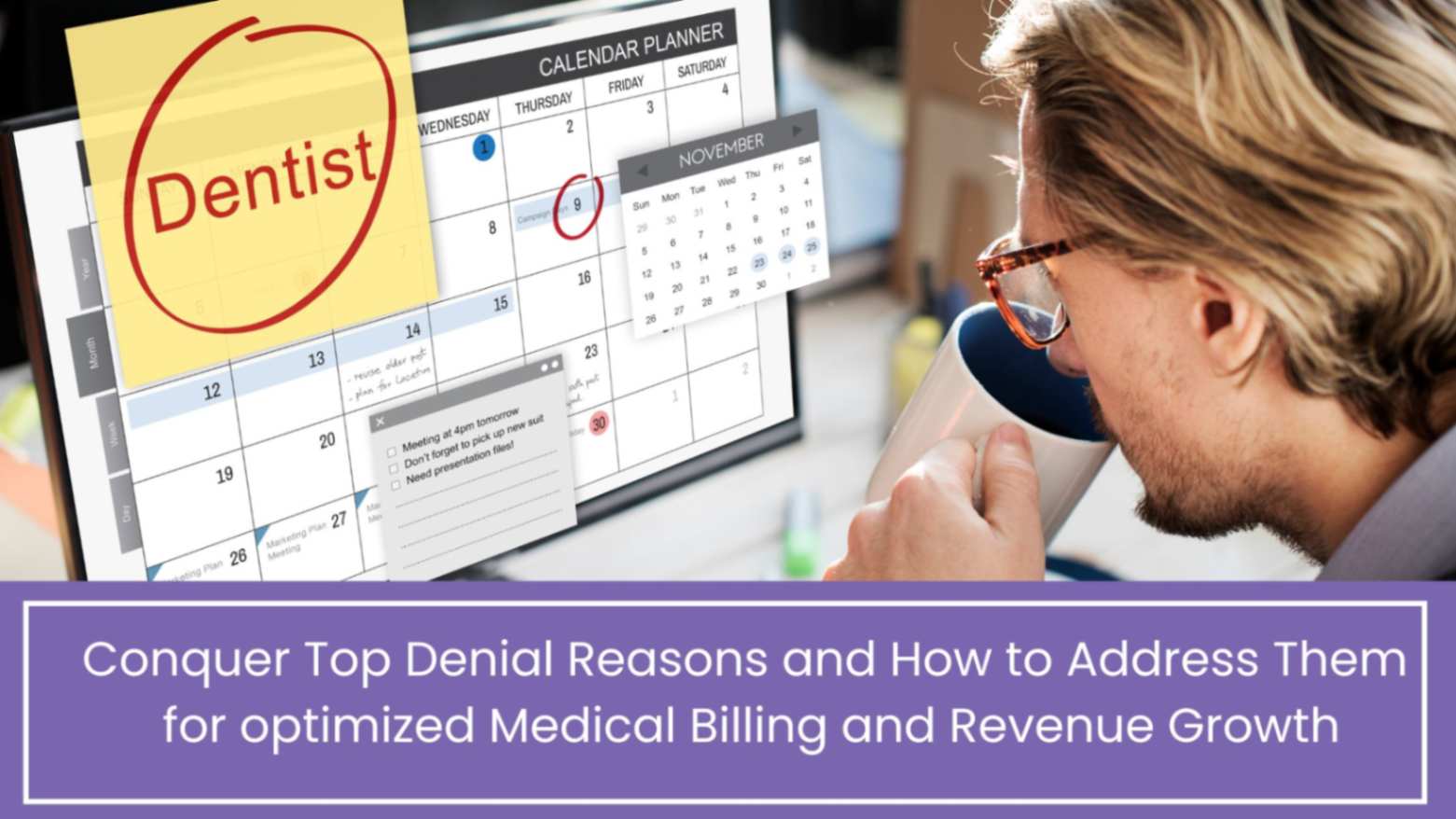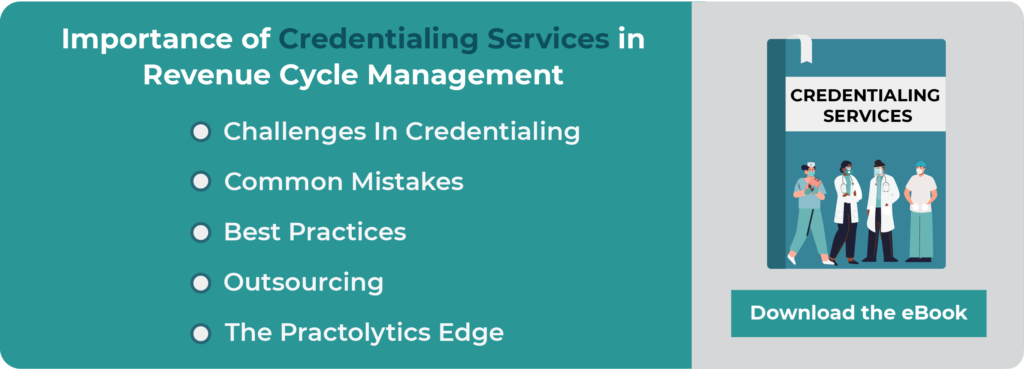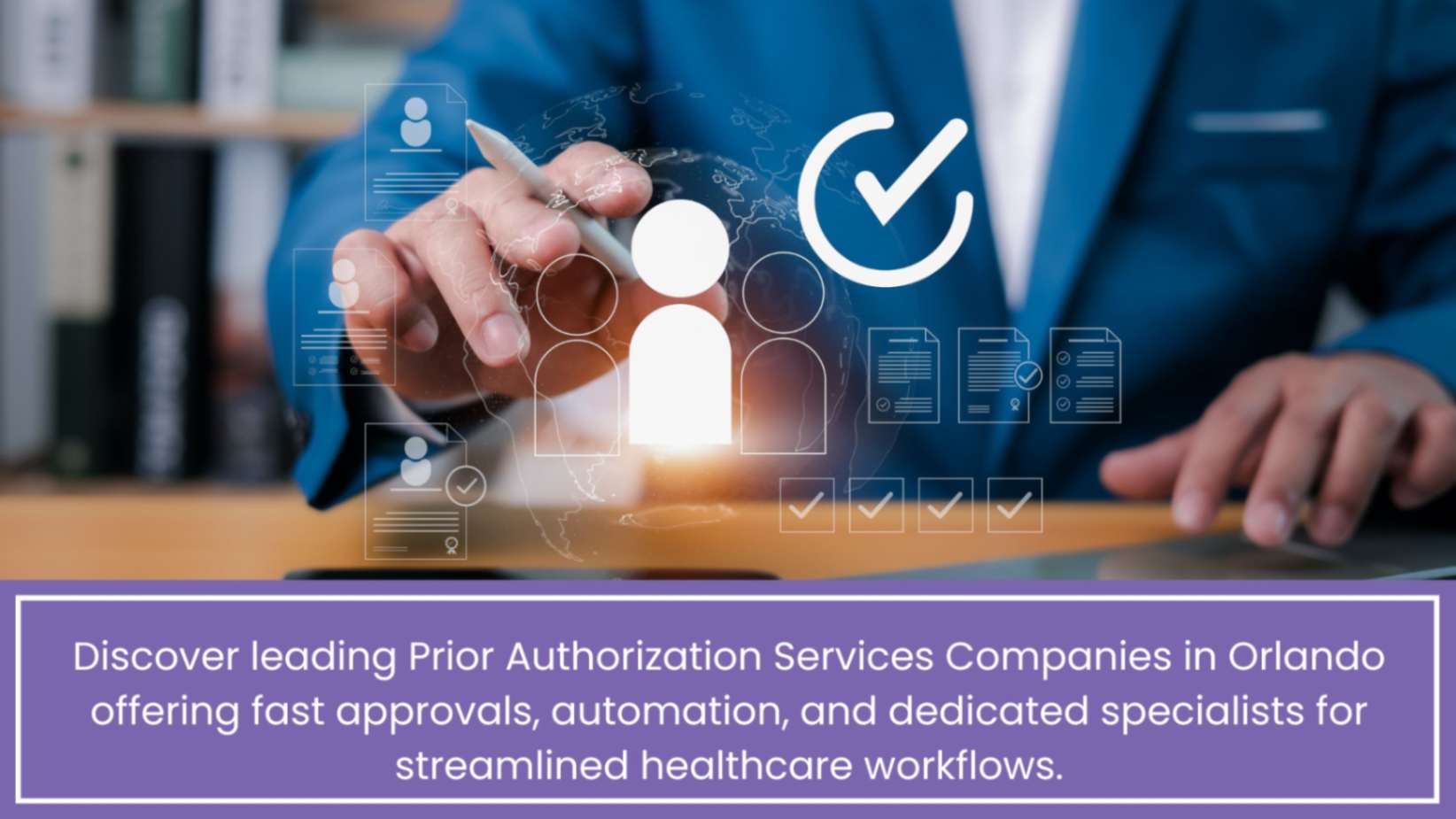Top Denial Reasons and How to Address Them
Denials of medical claims are a widespread problem in the healthcare industry that have an immediate effect on the operational effectiveness and financial stability of a practice. Maintaining a healthy revenue cycle requires knowing the Top Denial Reasons and How to Address Them. In addition to offering a checklist to reduce medical claim rejections, this thorough guide will examine the most common reasons for denials and suggest practical resolution and preventative techniques. Healthcare providers can greatly minimize revenue leakage and improve their financial performance in 2025 and beyond by proactively controlling denials.
The process of medical billing is complicated, and even with the best of intentions, claim denials continue to be a costly and ongoing problem for healthcare providers. Denials affect a practice’s profitability in the long run by delaying reimbursement and wasting staff time on appeals and rework. A thorough comprehension of the Top Denial causes and how to handle them is crucial to preventing this. This proactive approach transforms denial management from a reactive cleanup task into a strategic component of revenue cycle optimization.
Table of Contents
Landscape of Medical Claim Denials in 2025
With payer regulations always changing and a growing reliance on automated technologies for claim adjudication, the healthcare revenue cycle is dynamic. Revenue cycle 2025 denial data suggest that denial rates are continuously increasing; according to some reports, up to 15% to 20% of claims are rejected at the outset. Additionally, a sizable portion of these rejected claims are never resubmitted, which results in a large loss of money. The administrative expense of appealing, which can average more than $180 per claim, is another aspect of the financial impact of denials that goes beyond the original loss of payment.
Common factors contributing to the rising denial rates include:
- Insurers are constantly updating their guidelines. This makes it difficult for practices to keep up.
- Insurance firms are using artificial intelligence and complex algorithms to automate claim processing. This automation helps them find claim irregularities and increase denials.
- Payers require more detailed and precise clinical evidence to substantiate medical necessity. This evidence is needed to support claims for medical services.
- Billing departments can experience errors and missed deadlines due to staff shortages. High staff turnover in these departments can also contribute to these issues.
Addressing both individual claims and institutional changes is necessary to comprehend and resolve the Top Denial reasons. These changes are necessary to effectively resolve denial issues.
Most Common Denial Codes for Medical Billing
Effective denial management begins with an understanding of the Most Common Denial Codes in Medical Billing 2025. Each payer has unique CARCs and RARCs, but the underlying reasons for claims adjustments are often similar. The fundamental causes of claim adjustments are frequently the same across payers. Some of the most popular categories are as follows:
- Eligibility and Benefits Issues (CO 27, CO 109, CO 22):
Reason:
Coordination of Benefits (COB) difficulties, policy expiration, service not covered by the plan, or patient not covered on the date of service.
How to Address:
Implement robust eligibility verification for medical practices before the service. Check coverage for all visits. Ensure accurate and complete COB details for both primary and secondary payers. This includes all relevant information.
- Incomplete or Missing Data (CO 16):
Reason:
Any missing field on the claim form, such as patient ID, group number, referring physician NPI, or date of service.
How to Address:
Implement a checklist to minimize medical claim rejections. Use claim scrubbing software to catch errors before submission. Train staff to meticulously review all data fields.
- Prior Authorization/Referral Issues (CO 15, CO 151):
Reason:
The number provided is invalid, the required prior authorization services was not obtained, or it has expired. Service performed without a necessary referral.
How to Address:
Create a precise procedure for determining if a referral or prior authorization is required before scheduling or carrying out the service. Track authorization validity periods. Automated prior authorization tools can significantly help.
- Coding Errors (CO 4, CO 11, CO 50):
Reason:
Medical necessity denials can occur due to various reasons, including incorrect codes or diagnoses. It also includes unbundling, missing or erroneous CPT, ICD-10, or HCPCS codes, inaccurate modifiers, or a lack of supporting diagnosis for the procedure. These problems may lead to the denial of claims.
How to Address:
Engage in programmers’ certification and continuous training. Utilize current coding guidelines and updated codebooks. Implement claim scrubbing tools with NCCI edits. Conduct regular internal audits to identify coding patterns leading to denials. Focus on preventing coding-related denials in claims through specificity and accuracy.
- Timely Filing (CO 29):
Reason:
The claim was submitted after the payer’s deadline.
How to Address:
This is among the most annoying and frequently unassailable denials. Implement strict denial resolution workflow for medical practices that includes tracking submission deadlines. Make submitting claims a top priority, and whenever feasible, file electronically.
- Duplicate Claims (CO 18, A1):
Reason:
submitting a claim for the same service more than once without marking it as a corrected claim.
How to Address:
Implement robust claim tracking systems. Resubmit claims using the proper resubmission codes only in cases where they have been expressly rectified or challenged.
How to Successfully Appeal a Denied Insurance Claim
An appeal that is properly handled can recover a sizable portion of refused claims. It’s crucial to understand how to successfully appeal a denied insurance claim:
1.Recognize the Denial rationale: The denial code and rationale will be found in the ERA or EOB. This is your starting point.
2.Examine the Primary Cause: Fixing the surface mistake is not enough. Analyze the justifications for the rejection. Was it a misreading of payer policy, a coding error, a clerical error, or a technical issue?
3.Acquire the EOB/ERA and patient’s medical records (chart notes, surgery reports, test results). Compile the original claim and any applicable clinical guidelines or payer restrictions.
4.Write a Powerful Letter of Appeal:
- The patient’s name, policy number, date of service, and claim number should all be prominently displayed.
- Consult the particular denial code and justification.
- Concise, professional explanation of why the claim should be paid, referencing supporting documentation.
- Cite medical necessity with clinical evidence.
- Please reprocess this claim for payment” is an example of a specific resolution that might be requested.
5.Respect Payer Deadlines: Payers have stringent appeal deadlines, such as 30 to 180 days after the date of denial. Submit your appeal well in advance.
6.Important documents should be sent with a return receipt via certified mail. Use a technique that offers confirmation of receipt for entries made electronically.
7.Follow up on the appeal status. Document every interaction, including date, time, representative name, and discussion summary.
8.Internal appeals are subject to denial, and if so, understand the process for external or independent medical review. This process may involve a third-party reviewer.
Payer-Specific Denial Reasons and Fixes
One of the greatest challenges is the variation in payer-specific denial reasons and fixes. What one payer deems medically necessary may be covered by another.
- Engage in webinars and subscribe to payer newsletters to stay up to date on billing changes. Also check provider portals for more details.
- Make sure you comprehend the terms of your contracts with each significant payer by reviewing them. This aids in determining the payer-specific covered services, reimbursement schedules, and appeal procedures.
- Payer-Specific Denial Analysis: To find patterns, group denials according to payer. It is necessary to improve documentation or pre-authorization procedures for a payer if they routinely reject claims of “lack of medical necessity” for a certain therapy.
- Dedicated Payer Liaisons: For larger practices, having staff dedicated to understanding the nuances of specific payers can be highly beneficial.
Denial Resolution Workflow for Medical Practices
An organized denial resolution workflow for medical practices is paramount.
- Daily EOB/ERA Review: As soon as a refusal is received, note it.
- Sort denials according to payer and reason code for categorization and prioritization. Prioritize high-value claims or those with a higher likelihood of overturn.
- Root Cause Analysis: For each denial type, conduct a thorough investigation to identify the “why.”
- Correction & Resubmission/Appeal:
-
- Correct mistakes (such as a missing modifier or an invalid patient ID) and submit again as soon as possible for soft denials (rejections).
- Hard Denials: Start the appeal procedure by compiling supporting material and writing letters of appeal.
- Tracking & Monitoring: To keep tabs on the progress of all rejected claims and appeals, use denial management software. Make follow-up date reminders.
- Feedback Loop: In order to stop denials in the future, it is essential to transmit information from denials back to the front-end (patient registration, eligibility verification) and mid-cycle (coding, charge capture). This is where actionable denial resolution strategies for clinics truly make a difference.
- Performance Reporting: Examine denial rates, the most common causes for denials, and resolution rates on a regular basis. Make use of these analytics to show the results of your work and pinpoint areas that need development.
Checklist to Minimize Medical Claim Rejections
Reduce claim denials by using this:
- Each visit should include the patient’s name, date of birth, address, and insurance ID.
- Eligibility for Insurance: Verify the precise coverage and perks. Confirm the effective dates of your coverage.
- Getting the required pre-approvals and recommendations well in advance is important.
- Medical need: Verify that all services’ paperwork demonstrates their medical need.
- Reliable coding requires correct CPT, HCPCS, and ICD-10 codes. Make judicious use of modifiers.
- Timely Filing: Send in claims by the due dates specified by the payer.
- Complete Documentation: The patient’s documentation needs to have comprehensive records of every service provided.
- Claim Scrubbing: Before submitting, use automated software to find problems.
- Rules Particular to Payers: Keep abreast of the particular criteria for every major payer.
- Teach your employees how to code, invoice, and prevent denials.
- Appeals Procedure: Provide a stated procedure for contesting denials. Include sample letters and necessary proof.
Actionable Denial Resolution Strategies for Clinics
Beyond the workflow, clinics can adopt several actionable denial resolution strategies for clinics:
- Use advanced technologies like Denial management software, AI-powered predictive analytics, and automated claim scrubbing tools can all improve accuracy while reducing manual work.
- Assign staff members to appeals and denial follow-up. Create a dedicated denial management team or specialist. Greater efficiency and expertise are the results of specialization.
- Actively Communicate with Payers: Establish rapport with payer agents, particularly on persistent problems.
- Clinics struggling with high rejection rates or a lack of personnel may find outsourcing medical billing to a firm with strong denial management capabilities more affordable. When compared to internal staffing, this may be a more economical option.
- Continuous education is crucial. Regular training on payer policy, new codes, and industry best practices is crucial.
Preventing Coding-Related Denials in Claims
Preventing coding-related denials in claims requires specific focus:
- Coder Certification and Continuing Education: To keep up with developments, make sure your coders are certified and routinely attend continuing education classes.
- Internal Audits: Verify coding correctness against clinical documentation on a regular basis.
- Physician Education: Inform healthcare professionals on the significance of thorough and detailed documentation in order to justify coded services. Programs for improving clinical documentation (CDI) are essential.
- National Correct Coding Initiative (NCCI) modifications: To avoid unbundling and other coding problems, put in place systems that automatically apply NCCI modifications.
- Modifier Usage Review: Regularly review the correct application of modifiers as these are frequent sources of denial.
FAQ’s:
1.What are the Most Frequent Denial Codes in Medical Billing 2025?
Eligibility/coverage concerns (CO 27, CO 109), incomplete or missing information (CO 16), prior authorization issues (CO 15), coding errors (CO 4, CO 11, CO 50), and timely filing issues (CO 29) are the most common denial codes in medical billing in 2025.
2.How to appeal insurance claim denial effectively?
To successfully appeal a denied insurance claim, you must first understand the reason for the denial. Then, gather all relevant administrative and medical records. Write a succinct and understandable letter of appeal. Give a compelling argument for reconsideration and clearly outline the reasons for rejection. Pay close attention to the appeal’s progress. Submit the appeal within the payer’s allotted period, using trackable methods.
3.What is a denial resolution workflow for medical practices?
For medical practitioners, a denial resolution workflow is a methodical approach to handling rejected claims. Usually, it entails locating denials, examining the underlying reasons, classifying them, fixing mistakes or contesting the claim, monitoring the appeal’s progress, and—most importantly—feeding back insights to front-end procedures to stop similar denials in the future.
4.How can clinics prevent coding-related denials in claims?
Continuous coder education and certification, frequent internal coding audits, training providers on thorough clinical documentation, using claim scrubbing software with NCCI edits, and closely monitoring modifier usage for correct billing are all necessary to prevent coding-related denials in claims.
Conclusion:
The financial stability of every medical practice depends critically on how well Top Denial causes are managed and addressed. Providers can enhance their revenue cycle by comprehending the most common denial codes in 2025 medical billing sector. Also, by putting strong denial resolution workflows in place, and taking proactive measures to avoid rejections in the future. The healthcare setting in 2025 is shifting from reactive repairs to proactive prevention. This shift in approach, supported by technology and staff education, leads to higher clean claim rates. For healthcare companies, this ultimately means less administrative work and more financial security.
One of the biggest risks to revenue cycle performance in 2025 will continue to be claim denials. This thorough guide examines the main reasons why medical billing is denied as well as practical ways to avoid them. Learn how to handle the complicated rejection landscape with useful tools and insights, covering everything from eligibility verification and Prior authorization Services concerns to coding problems and payer-specific regulations. Learn how to create a denial resolution procedure, successfully appeal insurance claims that have been refused, and avoid expensive rejections by using internal audits, automation, and training. The site also offers advice for clinics on how to deal with denials linked to coding and a checklist to reduce rejections. Healthcare providers may increase clean claim rates, cut down on administrative waste, and protect financial health in a changing payer environment by emphasizing proactive prevention and real-time tracking.
ALSO READ – Prior Authorization for Specialized Forensic Testing: A Case of Cost and Time Savings
Talk to Medical Billing Expert Today — Get a Free Demo Now!






